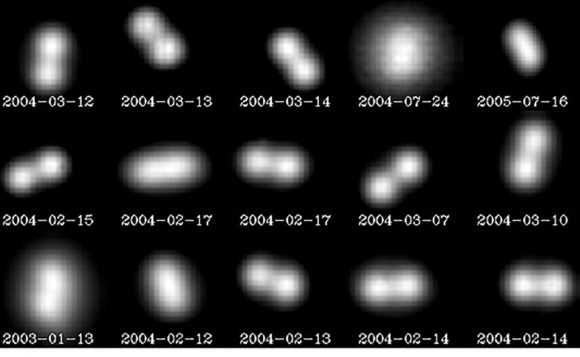Wonderful news! Asteroid 2004 BL86, which passed closest to Earth today at a distance of 750,000 miles (1.2 million km), has a companion moon. Scientists working with NASA’s 230-foot-wide (70-meter) Deep Space Network antenna at Goldstone, California, have released the first radar images of the asteroid which show the tiny object in orbit about the main body.
While these are the first images of it, the “signature” of the satellite was seen in light curve data reported earlier by Joseph Pollock (Appalachian State University, North Carolina) and Petr Prave (Ondrejov Observatory, Czech Republic) according to Lance Benner who works with the radar team at Goldstone.
2004 BL86 measures about 1,100 feet (325 meters) across while its moon is approximately 230 feet (70 meters) across. The asteroid made its closest approach today (Jan. 26th) at 10:19 a.m. (CST), however it will peak in brightness this evening around 10 p.m. (4:00 UT) at magnitude +9.0. Unlike some flybys, 2004 BL86 will remain within a few tenths of a magnitude of peak brightness from 6 p.m. tonight (CST) through early tomorrow morning, so don’t miss the chance to see it in your telescope.
Don’t expect to see the diminutive moon visually – the entire system will only appear as a point of light, but I’m sure you’ll agree it’s cool just knowing it’s there.

Among near-Earth asteroids, about 16% that are about 655 feet (200 meters) or larger are either binary or triple systems. While that’s not what you’d call common, it’s not unusual either. To date, we know of 240 asteroids with a single moon, 10 triple systems and the sextuple system of Pluto (I realize that’s stretching a bit, since Pluto’s a dwarf planet) – 268 companions total. 52 of those are near-Earth asteroids.
With a resolution of 13 feet (4-meters) per pixel we can at least see the roughness of the the main body’s surface and perhaps imagine craters there. No details are visible on the moon though it does appear elongated. I’m surprised how round the main body is given its small size. An object that tiny doesn’t normally have the gravity required to crush itself into a sphere. Yet another fascinating detail needing our attention.
Of course the main asteroid will get your attention tonight. Please check out our earlier story on 2004 BL86 which includes more details as well as charts to help you track it as it flies across Cancer the Crab tonight. This is the best view we’re going to get of it for the next two centuries.


And it looks like its spin has nothing to do with the orbit of the moon. Captured? Is this typical of the multiple moons where we know of the spin of the main asteroid?
Steven,
It certainly doesn’t seem to be orbiting in the plane of the equator but interpreting radar imagery can be tricky.
I seem to recall various science news snippets that such orbits were unstable but it might be from the main body having an equatorial bulge and this might not….
Could it be a UFO ?
No Steve, it’s the toilet of an interplanerary truck-stop (BL 86)
This tiny moon seems to orbit on the poles of this Asteroid wow! this is interesting indeed…Yet another great story from Bob!
Thank You Bob for bringing us these amazing radar pics.
I see that the prevailing hypotheses seem to be on the lighter side.
Let me add my 2 cents in Canadian currency by revealing that I’ve been practicing my line: “Esscuse me, vere are se nuclear wessels?”.
Sounds pretty good with a french-canadian accent 😉
You’re welcome BC. Still wondering why the moon appears to be revolving NOT anywhere near the plane of the equator. Illusion?
If this tiny rock was captured on it’s way by “accident”… it shouldn’t be no wonder why it’s plane of movement has a different alignment. If Voyager 1 would have been slower… it could orbit Saturn on a polar orbit, too 😉
TedH,
It could be that but another possibility could be precession of the main body’s axis. From one perspective the moon would appear to orbit like we saw it in the radar images. At another time and perspective it would appear to circle the main body differently.
Wanted to share this with everyone from reader Art Neuendorffer to help illuminate and answer the question of the moon’s orbit:
“The moon does “appear” to be revolving in an orbit perpendicular to that of the main body… but that is an illusion.
The left/right x-axis is really just the forward/back Doppler shift axis that has been scaled specifically to simulate an x-axis for the solid rotation of the primary (about some y-axis perpendicular to the viewing direction). The moon is ‘probably’ in very slow synchronous rotation about the primary (rotating about the same y-axis) making both the moon & it’s orbit highly elongated in this scaling mode.
The picture could easily be rescaled to fit the solid rotation of the moon (or, perhaps, even the elliptical orbit of the moon) but there is no simple way to determine what the relative axes of the rotations & orbits actually are(; at least, until the system has fully passed by so as to be observed from a number of different viewing directions).”
The “King-Neuendorffer” Maneuver ?
😉